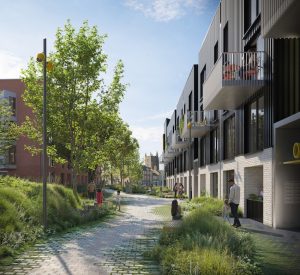Revitalising retail: navigating challenges and embracing sustainability

The landscape of the UK retail industry stands at a crossroads, confronting a multitude of challenges.
In the basement offices of a converted smart London townhouse near Tottenham Court Road, sponsored by leading prop-tech company Nimbus, a panel of retail experts gathered to discuss how they are navigating soaring rents and operational costs while keeping an eye on sustainability and how the recent changes have impacted independents compared to the large chains.
The round-table discussion heard from speakers representing the Canary Wharf and The Crown Estate, The Co-op and beauty retailer Lush as well as data analysis from Caci and The Local Data Company.
Grappling with going green
As we get closer to changes to the minimum energy ratings (with the minimum rating likely to be increased to a C by 2027 and a B by 2030), landlords and tenants are currently grappling with “green leases”.
This is causing arguments between occupiers and landlords over whose obligation sustainability is and to what extent landlords can pass the buck to the tenant.
With more than 400,000 sq. ft of sheds, Lush’s industrial portfolio is bigger than its physical stores. The firm is at the front of the pack on sustainability, with more than 60% of what it sells free of packaging.
Ellen Peters, head of property at Lush said: “Sustainability is not optional. Everyone’s busy trying to justify otherwise, but it’s too late. We all need to be doing it.
“We have an in-house buying team who created about 60 pages on what products we are allowed to use, with everything on a traffic light system. It shows us which product is better to use based on its ingredients, but the cost impact of this is massive, especially as we don’t cookie-cutter our stores.
“We’re going beyond our physical stores, so at Christmas, we offered our customers £40 to spend with us if they switch to Ecotricity because a lot of what we do is scope three”.
On the topic of green leasing, she said that it is “getting in the way of the collaboration part” of being sustainable.
“There’s a lot of focus on release clauses and who’s taking responsibility for certain things and arguing about that – rather than asking how we can work together to do something about it”.
Rob Tindale, acquisitions manager at Co-op, emphasises that being sustainable is a costly business and the reality is that every single fit-out it does must work financially as a priority.
“When looking at marginal models for stores, the focus is on numbers. When you nail down the operations of our store, and then put an extra 100/150/200 – it will kill the store. From a micro-level point of view, every single store must be profitable”.
Leanne Catterall, director of retail, hospitality and leisure leasing at Canary Wharf, thinks there is too much lip service around green issues and not enough is being done.
“The conversation on green leasing is “always disappointing”, she said. “There are very few clients who have their sustainability strategy together and I just wonder – how are we even here? This is happening! No one wants to take
responsible including the Government”.
Canary Wharf: a regeneration success story
Canary Wharf has been attempting to move away from being known as a pure office destination and has recently set out plans for its “3.0 vision”.
It’s embarked on the largest urban regeneration project in Europe, with its second phase creating a residential community for 3,500 residents to develop a mixed-use neighbourhood – growing to 8,000 residents by 2028.
For Canary Wharf 3.0, Catterall believes that bringing in popular retail brands will be vital to achieve this.
She said: “We have more than doubled our hospitality portfolio since Covid. There were 33 restaurants and now there are 79 and that figure is going to grow again this year.
“Our demographic has completely changed. Our retail offering used to provide for the high-end office worker that everybody thought was there – and now those brands are no longer there.
“As part of my vision, we want to completely change the mix. We want to bring in more accessible brands and create moments of flagship retailing so that we can start to uncover those parts of the portfolio that are suffering”.
While high streets and shopping centres are hit by the working-from-home era, with many workers only coming into cities on Tuesdays, Wednesdays and Thursdays, Canary Wharf benefits from staff being in the office on Mondays too.
However, as a bonus, Catterall said that Fridays and the weekend are the site’s busiest days thanks to the mixed-use offering, with people coming from way outside of London to new openings.
People also feel safe there, she says. Thanks to AI tracking cars and behaviour, visitors are now 90% more likely to have no crime around them in Canary Wharf.
“If someone is loitering the cameras now pick it up and our teams are trained so that the approach isn’t, ‘What are you doing? Move on’, it’s now, ‘Are you okay? Can we help you? Do you need orientating?’. There’s been a lot of training on language”.
Canary Wharf has been working with Tower Hamlets Council on providing community infrastructure through a Section 106 agreement.
Part of its next phase will see people and businesses from Tower Hamlets set up shop in Canary Wharf in an affordable and accessible way.
Catterall said: “I’m glad that we’re doing that. If we can execute the programme in a good way, then there will be nothing else like it in London.
“The idea is that we want to run a competition so that it feels a little bit more inclusive, rather than appearing in front of a scary landlord to put forward your landlord pack and be assessed on whether you’re good enough or not. It needs to be accessible as it’s really important how we engage with the community”.

Looking outside of London, The Crown Estate has a portfolio that includes 16 retail and leisure destinations covering over five million sq. ft of space in city centres and out-of-town locations.
With around an estimated 100 million visits each year, sites include Fosse Park in Leicester, Rushden Lakes in Northamptonshire, and joint ventures at Princesshay in Exeter, Westgate in Oxford and Crown Point in Leeds.
Will Hodge, customer partnership manager for retail at The Crown Estate, discussed how the firm is treating operations differently outside of London.
He said: “There’s a massive polarisation between the type of brands you’re trying to do a deal with, but also the reason they’re looking to transact with you.
“With the likes of Regent Street, I think it’s as much about marketing and entry to a new market for a brand whilst, on our other projects on places, such as Fosse Park, people are there because they need to make sure that the store makes money and their decision-making behind that comes from a different angle.
“It’s a purer form of retail and the pool of interest parties is much smaller. In somewhere like the Southwest, for example, the amount of people that you can pull in because there is so little competition in the market is huge. In the West End, you’re fighting off against Mayfair to the King’s Road into Canary Wharf. It’s a much stickier place to transact”.
The inflationary squeeze
Rob Tindale, acquisitions and development manager at the Co-operative Group reflected on the last few years as the market became “quite saturated”.
He said that the business spent, “18 months to two years where we downed tools to try and get our debt down, and during that time, the likes of Tesco ramped up their acquisitions, ASDA entered the market, Amazon came back into the market, Sainsbury’s increased their activity and now M&S I believe are coming back into the market and expanding their team as well.
“From an occupier, competitor side, it has become quite a saturated market, but this has tailed off in the last 12 months, mainly due to interest rates, and planning constraints, we’ve found it very difficult.
“With inflation, your labour costs and food costs have not been able to be passed onto the consumer and it’s made the model very challenging.
“Four years ago, we were realistically looking at a market where we think we could have taken 100 sites a year out. Now, I think we have that aspiration, but I think realistically, given the nature of where we sit in the market, that’s
something that is significantly changed by competitors dropping out or interest rates significantly coming down. I think this will be the status quo for the next few years”.
The power of experiential retail
The high street has recently experienced the demise of The Body Shop, a brand that worked closely with the owner of Lush on product development.
On the firm’s collapse, Ellen Peters put it down to it “losing its niche” as it ultimately became “owned by giant corporates that tested on animals.
“We’ve looked at where The Body Shop’s closure has that has an impact on sales and it has a little bit but not considerably. We want to see more brands like them on the high street than not”.
For a brand like Lush, drawing people into stores has been fuelled by the provision of ‘experiential retail’.
Despite the size of the store, Peters said that you will be able to buy every single product at each site as “the quality of experience with the product should be the same”.
The rise of the independent
During and following the pandemic, there has been a big push to support independent and local stores. Figures from The Local Data Company found that during the pandemic there was a rise in independent retailers from 64% to 67%.
Lucy Stainton, commercial director at the Local Data Company said: “In 2021, we saw insolvencies and a lot of restructuring across the chains. There was a net loss of about 10,000 units during that time for the chains, but for independents, we saw a net increase of over 2,000.
“A lot of those businesses were in spaces that were maybe considered essential: i.e. there were a lot of convenience openings. But it showed that everybody was shopping locally and supporting local businesses.
“When Government support was pulled, we started to see that drop away. Shopping centre vacancies in 2021 and 2022 went up to 19.4% across the board – and while there’s a huge variance within that, it was high.
“At the same time none of the chains were particularly acquisitive, so a lot of our big institutional landlord clients were coming to us and asking us to identify local hero independents that they could approach and say – we can come up with something which commercially will make sense for you and it’s viable.
“Openings did increase, but the number of closures was huge last year by comparison. Chains were doing slightly worse than independents, which did stay a little bit robust, but they were both in decline”.
Major institutions getting in independent stores can be a challenge says Will Hodge from The Crown Estate, as “it all depends on what the landlord can afford to do to break down those barriers of entry to make it easier and more sustainable for those businesses.
“We’ve got our arcades where we’ve done some really beautiful work to deliver some stunning spaces and fit them out to a high standard, to give small businesses an opportunity and I think we’re starting to see the success.
“The problem is we then lose these guys in theory in the incubation model because we don’t have that next step for them to move to”.
Feeling the pinch
And whilst there has been this support for independent retailers, Josh Rose, partner at Matta says “Most people are feeling the pinch in some way”. “Are people able to visit their local butcher, spending an extra 20 or 30% on artisanal products, or are they going to go to a massive supermarket like Aldi or Lidl?
“The reality is that there’s a very small percentage of the market that can shop locally and they’re the ones with disposable income. Places such as Clapham and wealthy pockets of Cheshire can, but the majority of the country is feeling the pinch.
“Value proposition is mirrored in restaurants and hospitality. Brands such as Rosa’s Thai, Flat Iron, and Rudy’s, where you can be in and out for £20/£30 are doing well.
“Rents are high, rates are high, the minimum wage has gone up, and so have food and electricity costs, so the bottom line is getting squeezed, the top line is just a bit better. But these sites have got to work hard to sell products and if people aren’t in town as much, you’re not getting a Monday trade. People are feeling the pinch, and they don’t want to spend. They’re not going out as much and they’re drinking less”.
Changing habits
Footfall is down by 11% versus pre-Covid says Tolga Necar, principal consultant at data collection company Caci. He said that whilst it’s dropped, “spending is holding out. It’s not just because things have gotten more expensive, but the reasons that we are visiting retail and leisure destinations has fundamentally shifted”.
Caci recently tracked the admission profile of a visitor and didn’t ask ‘What was your reason for coming’ but instead based it on ‘What did we observe happening?’.
Necar said: “The trips that have been lost are the ones where people either have come in and not spent anything, or they’ve come in and they’ve just done on one or two small little purchases
“On the flip side, the trips that have increased are the engaged, long dwell time, multiple stores, with a mixture of food and drink leisure, which generate four times the trips than the ones that have been dropped off”.
Placemaking
The theme of ‘placemaking’, combining urban planning, design, and retail strategy, is vital for occupiers says Bradley Smith, acquisitions manager for Southern Co-op/Cobra Coffee (Starbucks).
Smith says: “You can’t just rely on two pieces of the pie. Our best sites are where you’ve got multiple reasons to be there. You need the social side, offices, residential – you need the whole lot to function to bring all those different people together. If you’re just relying on one sector, that doesn’t happen.
“We’ve been looking at drive-thrus and whilst that’s a key sector for us. If it’s pure roadside services and people aren’t stopping to get coffee, you’re not going to get any sales.”
“If you look at our sales across our different sectors, our best store is in a shopping centre, and generally outperforms some of the drive-thrus, which has been surprising”.
Leveraging returns
In recent years consumers have begun to bear the brunt of returning online goods, as groups such as Mike Ashely’s Fraser’s introduce fees if you wish to return.
For Tolga Necar, at CACI, the returns process has become “much more important” than delivery, as it’s “another touch point, you get to display your work to the customer, they might go on and buy something else and be engaged with the
brand”.
“With returns, the internal business policy for how they report, and record comes off of the store’s performance metrics. It varies from occupier to occupier and there is sometimes a little bit of a disconnect between the occupier and the landlord as to where the real benefits lie.
“From a landlord’s perspective, getting people through and having that opportunity to spill over into other stores is a real benefit creating an additional trip with additional potential to spend.
“There is evidence that having a physical presence will influence online sales. For example, with Zara, online sales are 40% higher in the catchment of a physical store.
“There will be some stores in suburban areas which have more return to fulfilment, but overall, in terms of engagement with that brand, it does have a beneficial impact on overall sales”.
Overview
As we see from these conversations, while stakeholders grapple with saturation, high rents, and rising operational costs, they are also inspired by the prospect of creating sustainable retail environments grounded in ethical principles, community engagement, and accessibility.
Each panellist spoke about striving to adapt to changing demographics, by creating immersive mixed-use experiences and inclusive local economies for the ever-evolving market.
The overriding call to action was to improve collaboration on sustainability, not just for strategic reasons, but also for moral ones.









